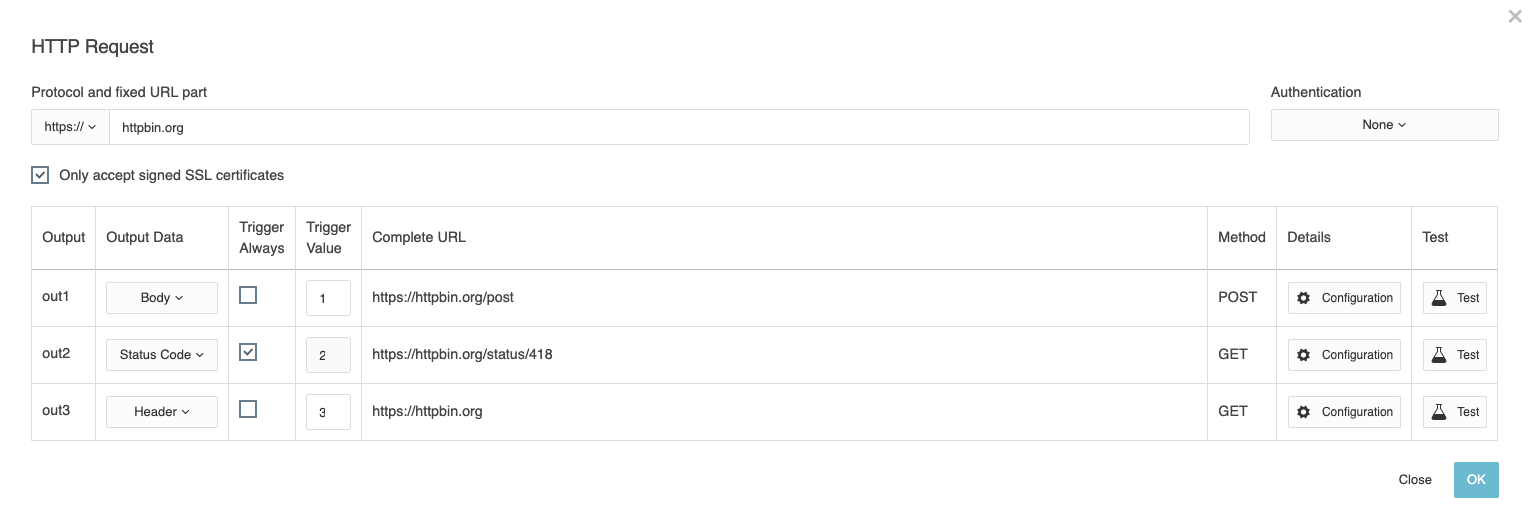HTTP Request
With HTTP requests you can request the status information of web-capable devices or forward it for further processing. In this way you are able to use a variety of different services in your own network or on the internet. From network-capable actors and sensors in your home network, to weather services, to news websites, you can use this logic element for the purposes of responding and processing.
Contents
Inputs and outputs
Inputs
GATE (see Logic Elements | Datapoint-Gate)
TRIG
Trigger for the configured HTTP requestsIN 1 ...
Up to 20 inputs for variable (dynamic) values in the requests
Outputs
OUT 1 ...
Every output corresponds one of the up to 20 configurable HTTP requests
Configuration
The configuration of the outputs/requests takes place via the gears icon in the logic element parameters. A modal dialog opens.

Protocol and basic URL
Set the web protocol to be used (http or https) and the basic URL. The strict certificate check for https connections can be deactivated via the checkbox below so that self-signed or expired certificates will be accepted as well.
Authentication
You can provide a user and password to authenticate requests. "Basic authentication" and "Digest Access Authentication" are supported. A corresponding Authorization HTTP header will be added to the requests.
Outputs
For every output, you must set a numerical trigger value (integer whole number) with which the corresponding request is completed. If a request is to be carried out independently of the trigger value at all times, please select the appropriate option.
At this point, please also set the form in which the result of the request is to be stated on the corresponding output. The following are possible:
Body
The result of the request without any header dataStatus code
An overview of the possible HTTP status codes is available on the internet.Header
The HTTP header of the response.Complete
The complete response as it is returned by the remote station. This contains the status, the headers and the body.
Advanced output / request configuration
In the straightforward configuration you set the number of inputs and outputs to be used and the maximum request duration (timeout). Further settings are available via the “Configuration” menu in the “Details” column. An additional dialog opens.
You can use the aforementioned dynamic (variable) input values (IN 1, IN 2 etc.) in the configuration for the appropriate request. To do so, position the cursor at the required place in the appropriate field and then use the mouse to click on the appropriate variable with the coloured background. A placeholder will be inserted at the corresponding location.
The format is "[[nameofinput]]".
Depending on your use case, we recommend using the logic element ordered output before HTTP Request elements. This way you can ensure that the inputs IN will be updated before the trigger input sets the request in motion.
Method and URL
Please set the request method before the further configuration. The screen contents change according to the method. The following are possible:
GET
PUT
POST
DELETE
With the GET method, for example, it is not possible to enter any HTTP response content as well.
The extension of the basic URL also takes place here. At the same time, please ensure that the required delimiter is provided (e.g. "/") between the basic URL and the extension. This is not provided automatically!
URL parameters
You must set the value pairs for URL parameters here. You can use dynamic input values for the key and the value.
With the actual requests, the URL parameters are attached to the URL shown above.
https://httpbin.org/query?key1=value1&key2=value2Please note that with a URL which is greater than 2,000 characters there is the risk that the corresponding web server will make an error.
Header
Please also provide random HTTP headers for the request. You can use dynamic input values for the key and the value. Examples:
Key | Value |
Accept | application/json |
Accept-Language | de-DE |
Authorization | Bearer 0b79bab50daca910b000d4f1a2b675d604257e42 |
Authorization | Basic QWxhZGRpbjpPcGVuU2VzYW1l |
HTTP response content
This option is not available for the GET method
Select the type before setting the HTTP response content. The editor which is situated below changes accordingly and provides some support during the input. If you select the “Key-Value Pairs” type, the text editor will be hidden and the input for the key and value are shown. This option is required if the counterpart is expecting form data.
According to the selected type, a corresponding “HTTP Header” is used.
Test
Since the logic element cannot be simulated, a test function is available in the “Test” column in the first dialog box (“Configuration”). If you have configured inputs for dynamic values, these will be retrieved before the actual test is run.
The actual request can take a little time. At the maximum, however, the configured timeout (plus a few seconds for the preparation and completion). An extra dialog box is displayed in order to show the results. Depending on the settings, these are the body, the header, the status code or the entire response.
///
